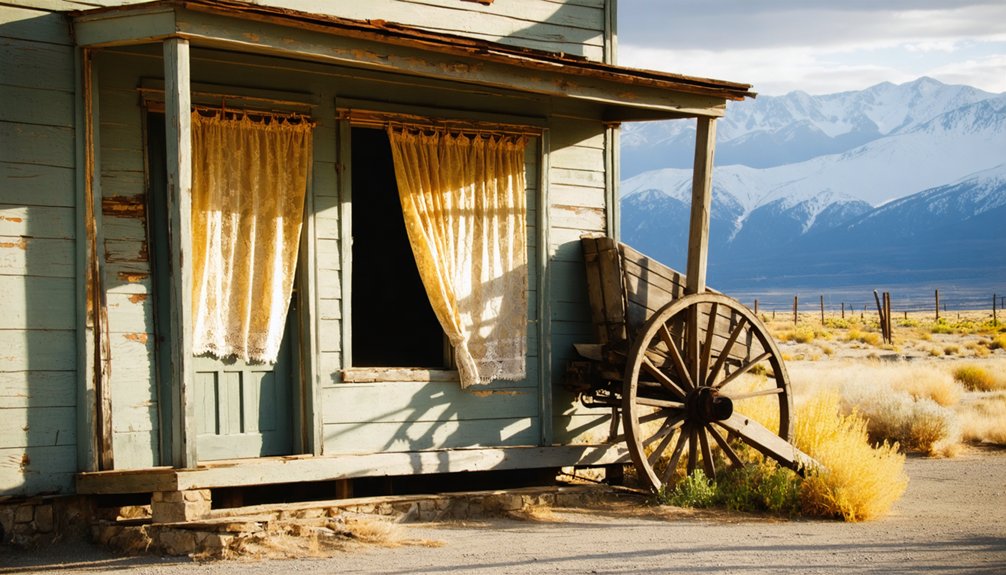You’ll find the abandoned silver mining town of Amalie in California’s Kern County near Tehachapi. The site features impressive mill ruins and the remains of the historic Flood family mansion from its 1890s mining heyday. Don’t confuse it with Alma in the Santa Cruz Mountains – they’re entirely different ghost towns. The weathered structures and rich silver mining heritage make Amalie a fascinating window into California’s industrial past.
Key Takeaways
- Amalie is an abandoned silver mining town near Tehachapi in Kern County, California, featuring historic mill structures and mining ruins.
- The site’s most prominent feature is a large abandoned mill building that once processed silver ore during the region’s mining peak.
- The Flood family mansion served as a social center for California’s mining elite, managed by Rose Flood during operations.
- The ghost town remains include weathered industrial structures that showcase California’s silver mining heritage and boom-bust economic cycles.
- Located near Caliente and Twin Oaks, Amalie’s ruins attract history enthusiasts seeking authentic glimpses of California’s mining past.
Setting the Record Straight: Alma vs. Amalie
When exploring California’s ghost towns, it’s crucial to distinguish between Amalie and Alma, two historically distinct locations that are sometimes mistakenly conflated.
For the sake of historical accuracy, you’ll find Amalie near Tehachapi in Kern County, where its abandoned silver mine and mill structures still stand as evidence of its mining heritage.
Similar to the arrested decay preservation at Bodie State Historic Park, Amalie’s remaining structures have been left untouched since its abandonment.
Alma, on the other hand, lies in the Santa Cruz Mountains with an entirely different history.
Nestled deep in the Santa Cruz Mountains, the ghost town of Alma tells a unique tale of California’s past.
The name differentiation isn’t just semantic – these places developed independently, with no overlapping history or connection.
You’ll discover Amalie’s extensive mining ruins near Caliente and Twin Oaks, while Alma’s story unfolds in Santa Cruz County.
Local historians, explorers, and documentary evidence consistently maintain this distinction, preventing any legitimate confusion between the two sites.
Like living ghost towns such as Randsburg, both locations preserve their unique historical identities through careful documentation and preservation efforts.
Life in the Santa Cruz Mountains
Life in the Santa Cruz Mountains offered you year-round recreation opportunities thanks to its Mediterranean climate, with temperatures rarely dipping below the 40s°F in winter or exceeding 80°F in summer.
You’d find locals and visitors alike exploring the network of trails through towering redwood forests, especially in areas receiving up to 60 inches of annual rainfall that sustained the lush ecosystem.
Between outdoor adventures, you might’ve caught wind of the latest mountain gossip at one of the small communities that dotted the rugged terrain, where residents adapted their lifestyles to the unique topography and climate patterns.
The winters brought the most rain to the region, with February’s 2.13 inches marking the wettest month of the year.
During particularly cold spells, thermal inversions would cause frost to form in the valleys while higher elevations remained relatively mild.
Mountain Recreation Hotspot
The Santa Cruz Mountains offer four distinct recreational spheres – land activities, water sports, parklands, and tourism infrastructure – making it one of Northern California’s most diverse outdoor destinations.
You’ll find nearly 40% of locals hitting the trails for hiking and mountain biking, while others enjoy fishing, kayaking, and surfing in nearby Monterey Bay. With 262 sunny days annually, you can pursue outdoor adventures year-round across 42,000 acres of state parks and 1,593 acres of county-managed lands.
You’re never far from adventure here – 44% of residents can walk to a park within 10 minutes. The region’s extensive network of trails and facilities supports everything from disc golf to horseback riding, while contributing to a thriving tourism economy that draws over 1 million visitors annually. The area’s unique outdoor experiences have been attracting visitors since the mid-1800s, drawn by the natural beauty and sunshine.
Local Drama Unfolds
Behind the serene mountain landscapes and outdoor recreation, social tensions shaped daily life in the Santa Cruz Mountains’ mining communities.
You’ll find stories of fierce competition over mining claims and limited resources, where survival often meant maneuvering through complex social dynamics in an unforgiving environment. The area saw massive changes when the Great Flood of 1862 washed away several settlements. Today, modern explorers like Curtis join first-time adventures into historic mines, connecting with the region’s rich past.
Local legends tell of disputes that erupted at general stores and communal gathering spots, while ghost sightings near old cemeteries added to the area’s mystique.
As mining operations rose and fell, you’d witness dramatic population shifts as families struggled through boom-and-bust cycles.
These tensions created lasting impacts that echo through time – evident in the abandoned buildings and ruins you see today, where the drama between preservation efforts and natural decay continues to unfold.
The Flood Family Legacy
You’ll find the Flood family’s impressive mansion perched strategically above the mining settlement of Amalie, where it served as both a symbol of their success and a vantage point to oversee operations.
Rose Flood, the family matriarch, transformed the mansion into a social hub, hosting elaborate gatherings that attracted California’s mining elite.
Her influence extended beyond mere social events, as she helped establish the Flood family’s prominence in California’s silver mining circles through strategic networking and business relationships.
Mansion Above the Lake
Standing majestically above the former mining town of Amalie, California, the Victorian-era Flood family mansion serves as a tribute to the region’s prosperous mining heritage.
The two-story wooden structure, with its wraparound porch and gabled roof, exemplifies the elegant mansion architecture of Western mining towns. Similar to the French Colonial style seen in historic Caribbean properties, you’ll find ornate woodwork, large fireplaces, and period furnishings inside this once-grand residence that’s now weathered by time and abandonment. Like Chicago’s Palmer House after the Great Fire, the mansion was rebuilt using massive loans to restore its grandeur.
- Perched on elevated terrain, the mansion’s strategic position offers breathtaking panoramic views of the Owens Valley below.
- The mansion’s deteriorating state and rich history have made it a magnet for ghostly encounters and paranormal investigators.
- Original Victorian colors, decorative trim, and historic outbuildings paint a picture of the region’s glamorous mining era.
Rose’s Social Rise
While natural disasters shaped much of California’s history, Rose Flood’s remarkable social ascent in Amalie emerged through her family’s response to environmental challenges.
You’ll find her story intertwined with the inheritance of Almadale, the family’s summer residence, which became a symbol of their resilience during the devastating floods of 1934, 1950, 1955, and 1964. The January 1934 flood brought nearly twelve inches of rainfall within days, testing the family’s resolve.
As social dynamics shifted in response to these natural calamities, Rose played a pivotal role in preserving the Flood family legacy through property maintenance and historical documentation.
Her influence extended beyond mere social status – she helped transform her family’s narrative into a reflection of flood resilience, connecting environmental challenges to cultural heritage in the Amalie region.
The preservation of Almadale stands as tangible proof of the Flood family’s lasting impact on California’s social landscape.
Crime and Controversy
- The explosive robbery left the town’s primary commerce center severely damaged, destabilizing local business.
- A teenage runaway’s scandalous marriage to James L. Flood sparked family denouncement and community gossip.
- Cult-related allegations, though dropped, resulted in the accusers’ banishment from the property.
- Explore the impressive mill building, where miners once processed silver ore during the region’s economic peak
- Walk among authentic ruins that haven’t been commercialized like other ghost towns
- Connect with California’s rugged past through tangible remnants of mining life
- https://www.sfgate.com/obscuresf/article/brief-history-of-a-Bay-Area-ghost-town-17397657.php
- https://parks.sbcounty.gov/opinion-beyers-byways-a-brief-history-of-calico-ghost-town/
- https://en.wikipedia.org/wiki/List_of_ghost_towns_in_California
- https://www.youtube.com/watch?v=0HucX63hVj0
- https://www.mojaveunderground.com/forum/forum/adventure/trip-reports/1129-amelie-mine-twin-oaks-ca
- https://www.youtube.com/watch?v=2IsG0j6-qRQ
- https://www.youtube.com/watch?v=nZWSFiIofpE
- https://enjoyorangecounty.com/california-ghost-towns/
- https://en.wikipedia.org/wiki/Santa_Cruz_Mountains
- https://www.timeanddate.com/weather/@5393093/climate
These events shaped Amalie’s transformation from a recreational destination to a place of notoriety and mystery.
Beneath the Waters

After the construction of the Lexington Reservoir Dam in the 1940s, the town of Alma disappeared beneath rising waters as part of Santa Clara County’s water supply and flood control initiative.
Today, you’ll find this submerged history revealed during drought periods when water levels drop dramatically, sometimes to just 8% capacity. The 1926 bridge remains nearly intact underwater, while stone foundations and building outlines create an underwater archaeology site that draws curious divers.
When drought strips away the reservoir’s waters, ghostly remnants of old Alma emerge from their watery tomb.
During the 2008 dam repairs, the drained reservoir exposed Alma’s foundations to daylight once again.
When you explore these waters, you’ll discover rock foundations, street remnants, and various structures lying 30 feet below the surface, though most wooden buildings have long since deteriorated.
Historical Significance and Modern Memory
Located near Tehachapi, California, the Amalie Mine stands as a tribute to the region’s silver mining heritage and boom-and-bust cycles.
As a ghost town, you’ll find its large mill building and support structures still standing, though weathered by time. The site exemplifies California’s mining era, where communities flourished and faded with the availability of precious metals.
Today, the abandoned complex draws history enthusiasts and explorers seeking to experience an unvarnished piece of mining heritage.
While less famous than other ghost towns, Amalie’s untouched state offers you a raw glimpse into California’s industrial past.
Frequently Asked Questions
Can Visitors Scuba Dive to See Remnants of the Town?
Purposefully prohibited paths prevent public scuba exploration at this location. You can’t dive here – there’s no underwater archaeology to see since Amalie isn’t submerged and remains a land-based mining site.
What Happened to the Residents When the Town Was Flooded?
You’ll find residents underwent a planned town evacuation before the flooding, with authorities relocating some to higher ground while others received financial compensation to establish new homes elsewhere.
Were Any Buildings Relocated Before the Reservoir Was Created?
You won’t find any evidence of building preservation or historical relocation from Alma. Records show all structures were either demolished or left behind before the valley was flooded for Lexington Reservoir in 1952.
What Native American Tribes Originally Inhabited the Area?
You’ll find that the Nisenan and Mountain Maidu Native American tribes shared this cultural heritage area, living along the river watersheds and foothills before European settlement dramatically changed their territories.
Did Any Famous Movies Film There Besides Broncho Billy Anderson’s Works?
You won’t find any other famous films or filming locations here beyond Broncho Billy Anderson’s silent Westerns from the early 1900s. No major Hollywood productions have used this site since.



